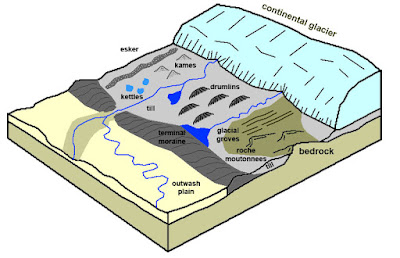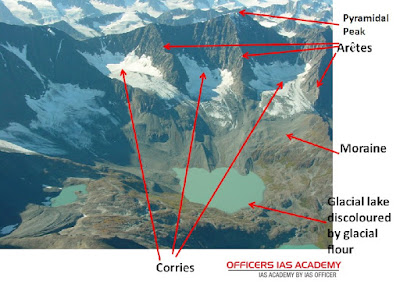THE WORK OF MOVING ICE :
·
Wherever the rate of snow melting or
its evapouration is lower than the rate of snowfall in a year, snow accumulates
into great mass of ice.
·
Permanently snow covered
regions of this type are called snow - fields.
·
Snow - fields occur in polar regions
and on high mountainous areas.
·
Snowfields are always
found above the snow line.
·
Snow line is an imaginary line above
which there is permanent snow.
·
The height of the snow - line
is not uniform and is affected by latitude, amount of snowfall, direction of
winds and slope.
·
A moving mass of ice and snow
is called a glacier.
·
In region experiencing snowfall, the
snow keeps on accumulating in layers one above the other.
·
Its overlying pressure is applied to
the underlying snow.
·
It is so great that snow in lower
layers becomes granular, hard and compact.
·
The pressure also quickens the melting
of some of the snow, which on refreezing starts turning into a granular ice.
·
Again it is the pressure of the
overlying layers which makes this solid mass of ice mobile.
·
This great mass of ice moving
more under its own weight is called a glacier.
·
Its velocity is very low
and it moves from a few centimetres to a few metres in a day.
Types of Glaciers :
(i) continental glaciers and
(ii)
valley glaciers.
·
A thick ice sheet covering
vast area of land is called a continental glacier.
·
The thickness of ice in such regions
goes upto thousands of metres.
·
Glaciers of this type build up at the
centre and move outward in all directions.
·
Continental glaciers of today are found
mainly in Antarctica and Greenland.
·
The precipitation in these regions
occurs in the form of snow.
·
It gets accumulated year by year
because of relatively slower rate of its melting.
·
When a mass of ice from the
high mountainous regions starts moving down into the pre-existing valleys, it
is called a valley glacier or a mountain glacier.
·
The shape of the valley glaciers
depends on the valley it occupies.
·
Where the valley is
broad, the glacier spreads outwards and where the valley is narrow, the glacier
contracts.
·
The longest glacier in
India is the Siachen Glacier in Karakoram
range which is 72 kilometres long.
·
Gangotri Glacier in
Uttarakhand is 25.5 kilometres long.
There are many smaller glaciers in other parts of the Himalaya. Their length
varies from 5 to 10 kilometres.
·
The two important rivers of India, the
Ganga and Yamuna, origin nate from Gangotri and Yamunotri
glaciers respectively.
·
As a glacier moves over the land, it
drags rock fragments, gravel and sand along with it.
·
These rock fragments become efficient
erosive tools. With their help glacier scrapes and scours the surface rocks
with which it comes in contact.
·
This action of glacier leaves behind
scratches and grooves on rocks.
The landforms created by
glacial erosion are:
·
Snow collects at the upper
end in a bowl shaped depression, is called cirque.
·
Layers of snow in the process of compaction and recrystallization are
called firn.
·
Sometimes the deepest parts of these
hollows are occupied by accumulated-water, to form
Corrie Lake (or Tarn).
·
The glacier does not
carve a new valley like a river but deepens and widens a preexisting valley by
smoothening away the irregularities.
·
In this process the glacier broadens the sides of the valley.
·
The shape of the valley formed in this
manner resembles the letter ‘U’.
·
It is therefore called a ‘U’ - shaped
valley.
·
Such a valley is relatively straight,
has a flat floor and nearly vertical sides.
·
Just like tributary streams
of river, there are tributary glaciers also which join the main glacier after
moving over their mountainous path.
·
These tributary glaciers like the main
glaciers carve U - shaped valleys.
·
However, they
have less volume of ice than the main glaciers and thus their rate of erosion
is less rapid.
·
As a result their valleys are smaller and
not as deep as that of the main glacier.
·
Due to this difference in deepening;
the valley of the tributary glacier is left at a higher level than that of the
main glacier.
·
The valley of the
tributary glacier just looks like hanging downwards
at the point of its
confluence with the main valley.
·
This type of a topographical feature is
called a hanging valley.
·
This feature is visible when ice has
melted in both the valleys.
·
When the ice in the hanging valley melts,
a waterfall is formed at the point of confluence of this stream with the main river.
4.Eskers :
· Glaciers can also contain sinuous flows of meltwater that occur in ice tunnels at the base of the ice.
· The beds of these sub-surface glacial streams are composed of layers of sand and gravel.
· When the ice melts from around the meltwater tunnels, the beds of sand and gravel are deposited on the Earth's surface as long twisting ridges known as eskers.
5.Drumlins :
· feature of continental glaciation are hill shaped deposits of till known as drumlins .
· A couple theories exist to explain their formation.
· The most excepted theory suggests they form when saturated ground sediments oozes up into hollows at the base of an advancing glacier.
· The sediment is then stretched out and molded into a streamline form as the ice moves forward.
6.Kettle hole :
· When glaciers are rapidly retreating, numerous blocks of ice can become detached from the main body of the glacier.
· If glacial drift is then placed around the ice, a depression on the surface called a kettle hole can be created when the ice melts .
· Kettle holes are commonly found on moraine and outwash plain deposits.
7.Outwash plain :
· Outwash deposits are formed when sand is eroded, transported, and deposited by meltwater streams from the glacier's snout and nearby till deposits to areas in front of the glacier.
· Outwash plain develops when there are a great number of meltwater streams depositing material ahead of the glacier.
8.Kame :
· Glaciofluvial deposits are also associated with the melting of stagnant ice at the front of the glacier.
· Where sediment rich water flows into a crevasse or depression in the ice, a conical-shaped pile of sand and gravel, known as a kame .
4.Eskers :
· Glaciers can also contain sinuous flows of meltwater that occur in ice tunnels at the base of the ice.
· The beds of these sub-surface glacial streams are composed of layers of sand and gravel.
· When the ice melts from around the meltwater tunnels, the beds of sand and gravel are deposited on the Earth's surface as long twisting ridges known as eskers.
5.Drumlins :
· feature of continental glaciation are hill shaped deposits of till known as drumlins .
· A couple theories exist to explain their formation.
· The most excepted theory suggests they form when saturated ground sediments oozes up into hollows at the base of an advancing glacier.
· The sediment is then stretched out and molded into a streamline form as the ice moves forward.
6.Kettle hole :
· When glaciers are rapidly retreating, numerous blocks of ice can become detached from the main body of the glacier.
· If glacial drift is then placed around the ice, a depression on the surface called a kettle hole can be created when the ice melts .
· Kettle holes are commonly found on moraine and outwash plain deposits.
7.Outwash plain :
· Outwash deposits are formed when sand is eroded, transported, and deposited by meltwater streams from the glacier's snout and nearby till deposits to areas in front of the glacier.
· Outwash plain develops when there are a great number of meltwater streams depositing material ahead of the glacier.
8.Kame :
· Glaciofluvial deposits are also associated with the melting of stagnant ice at the front of the glacier.
· Where sediment rich water flows into a crevasse or depression in the ice, a conical-shaped pile of sand and gravel, known as a kame .
(B) Transportational work of Glacier :
·
Although the glacier moves very slowly,
it drags with it large boulders and rock fragments.
·
Glacier gets this material from the mountain
slopes, valley sides, valley bottom and from air.
·
This material is called the load of glacier.
(C) Depositional work of Glacier :
·
When the glacier melts or retreats, it
deposits its load in different parts.
·
When the glacier melts, the debris are deposited at the end
of the valley glacier in the form of a ridge.
·
Morainic material ranges from fine clay
to large angular boulders.
·
The moraine which is deposited on either side of a glacier is called
lateral moraine.
·
When two glaciers join each other their
lateral moraines also join.
·
Moraines thus formed
on the confluence of two glaciers are called medial moraines.













































Great one!
ReplyDeleteReally nice... sir i have a doubt ....Fjord (scandinavia )...should we add it in glacial land forms?
ReplyDeletecan you give some examples of hanging and U shaped valleys from himalayan region..
ReplyDeleteur welcome
ReplyDeleteWow ..vry well defined
ReplyDeleteLike for us normal people don't know much such mountain things but you describe very good and provide more and more such info to us.
ReplyDeleteAMONGUS
ReplyDeleteSUSYBAKA
ReplyDeleteOBAMNA
ReplyDeleteEE
ReplyDeleteEEEEEEEEEEEEEEEEEEEEEEEEEEEEEEE
ReplyDeleteA SPORTS
ReplyDeleteGLIZZY
ReplyDeleteAMONGUS AMONGUS AMONGUS AMONGUS AMONGUS AMONGUS AMONGUS AMONGUS AMONGUS AMONGUS AMONGUS AMONGUS AMONGUS AMONGUS AMONGUS AMONGUS AMONGUS AMONGUS AMONGUS AMONGUS AMONGUS AMONGUS AMONGUS AMONGUS AMONGUS AMONGUS AMONGUS AMONGUS AMONGUS AMONGUS AMONGUS AMONGUS AMONGUS AMONGUS AMONGUS AMONGUS AMONGUS AMONGUS AMONGUS AMONGUS AMONGUS AMONGUS AMONGUS AMONGUS AMONGUS AMONGUS AMONGUS AMONGUS AMONGUS AMONGUS AMONGUS AMONGUS AMONGUS AMONGUS AMONGUS AMONGUS AMONGUS AMONGUS AMONGUS AMONGUS AMONGUS AMONGUS AMONGUS AMONGUS AMONGUS AMONGUS AMONGUS AMONGUS AMONGUS AMONGUS AMONGUS AMONGUS AMONGUS AMONGUS AMONGUS AMONGUS AMONGUS AMONGUS AMONGUS AMONGUS AMONGUS AMONGUS AMONGUS AMONGUS AMONGUS AMONGUS AMONGUS AMONGUS AMONGUS AMONGUS
ReplyDeleteCmd v
ReplyDeleteshut it
ReplyDelete